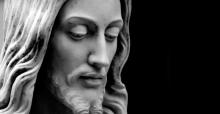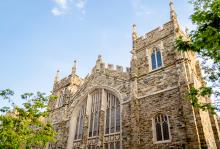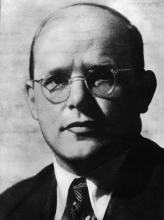deitrich bonhoeffer


Christian communities get romanticized as places populated with ideal human beings who reflect a pursuit of individual morality in a community of righteous individuals. Yet, in a society organized by race, ideal humanity is always white. Race has calibrated dominant streams of Christianity according to the goals of white supremacy rather than allowing the gospel to calibrate human social interaction toward justice. Christianity scrubbed of justice turned Jesus into a white man, and the gospel into a message of individual morality, calibrated to the language of virtue derived from Jesus as a fetish of idealized white masculinity.

Strange Glory: A Life of Dietrich Bonhoeffer is the second Bonhoeffer book by the University of Virginia religion scholar, Dr. Charles Marsh, whose many other books include analyses of civil rights figures and history. Marsh is himself a child of the south, and his authored works have centered on prominent figures who model a commitment to justice in the face of southern white supremacy. Strange Glory is no different. Marsh’s depiction of Bonhoeffer is the first cradle-to-grave biography to highlight the seminal nature of Bonhoeffer’s experience in America, with African Americans, for his prophetic resistance to Nazism. Marsh also speculates that Bonhoeffer harbored an unrequited longing for more than friendship from his student and closest friend, Eberhard Bethge. Yet, with Strange Glory, I find speculation about Bonhoeffer’s sexuality less intriguing than the question of what Marsh’s representation of Bonhoeffer intends to offer us today.
Bonhoeffer spent a significant amount of time in Harlem while he was a postdoctoral student in America at Union Theological Seminary during the 1930-31 school year. Bonhoeffer became a lay leader at Abyssinian Baptist Church, and many Bonhoeffer scholars believe that his time there was seminal for his prophetic Christian resistance to Nazis. Yet Bonhoeffer’s relationship with Harlem is somewhat ambiguous for the Bonhoeffer that Marsh constructs. Instead, he emphasizes Bonhoeffer’s travels through the Jim Crow South, positioning the south (or, southern blackness) over against the north or northern, Harlem blackness as the primary source of African-American Christian influence on Bonhoeffer.
In fact, Harlem blackness gets a bad rap in Marsh’s Bonhoeffer story with this juxtaposition of southern vs. northern blackness.

When people talk about the fall of humanity in the Jewish Genesis story, we never talk much about the Tree of Life. The Tree of the Knowledge of Good and Evil gets all the headlines and sermons because that’s the one that’s supposed to define us. That’s what we see, when we look around at humanity: The Fall, and a lot of evil triumphing over good.
Martin Luther, the father of Protestant churches, “was once asked what God was doing before the creation of the world,” according to German Lutheran theologian Dietrich Bonhoeffer. “His answer was that he was cutting canes for people who ask such useless questions.”
Who says you can’t offer a doctrine of abundant grace with a bit of sarcastic wit? For Bonhoeffer, this was really a question of why. Why did God create? What was going on, such that God decided to make a world? As Bonhoeffer saw it, this is a question rooted in guilt, shame, and fear. It’s really asking: What did God want of the world? What did God make me for? Am I living up to it? Am I accepted? It’s a question falling from the Tree of the Knowledge of Good and Evil, not the Tree of Life.

Today marks the 67th anniversary of the execution of Dietrich Bonhoeffer, the German pastor and theologian who was a member of the German resistance movement against Nazism in the 1930s and 1940s and a founding member of the Confessing Church in Germany, which represented a major source of Christian opposition to the Nazi government in Germany.
An outspoken critic of Adolf Hitler and the Nazi party, Bonhoeffer was arrested in 1943 and hanged at Flossenbürg concentration camp 9 April, 1945 – just a month before Germany surrendered and the War in Europe ended.
One of the most influential Christian thinkers and writers of the 20th Century, Sojourners today honors the memory of Dietrich Bonhoeffer.
“The ultimate test of a moral society is the kind of world that it leaves to its children.” – Dietrich Bonhoeffer.
My favorite characters in The Lord of the Rings are the Ents -- an ancient race of giant living, talking, breathing trees in J.R.R. Tolkien's fictional land, Middle Earth. I have a little confession to make: Whenever I hear a reading from Isaiah 55 where it says, "The mountains and hills before you shall burst into song and all the trees of the field shall clap their hands," I always picture the Giant Ents from The Lord of the Rings. And then I picture these clapping trees from Isaiah holding little Hobbits in their branch arms in what ends up a willful conflation of Middle Earth and Major Prophet.